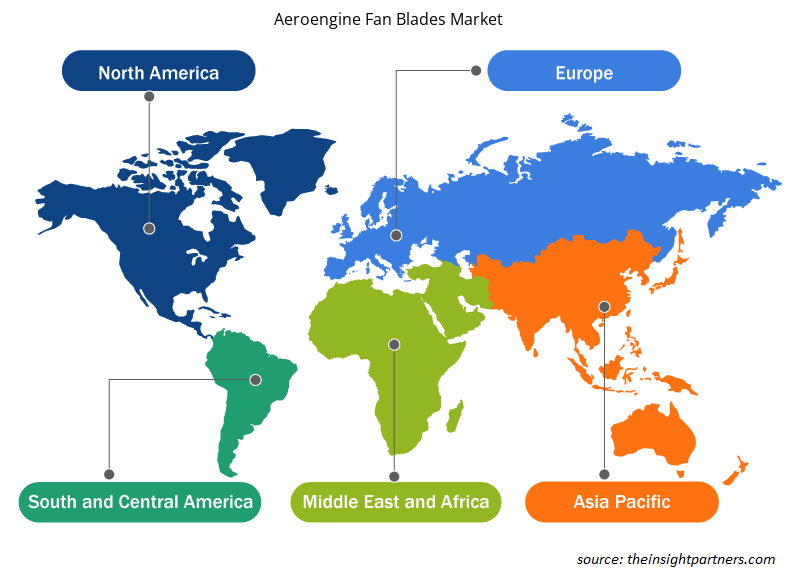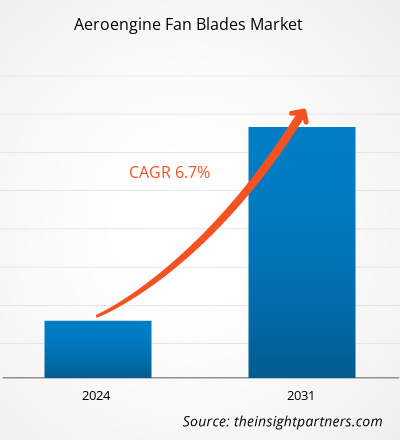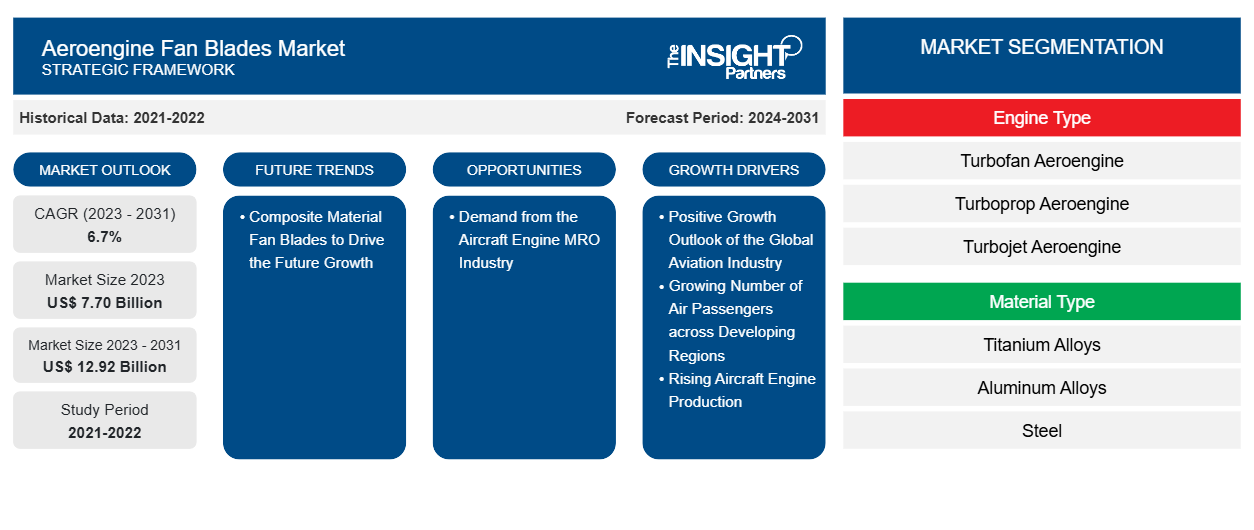Der Markt für Triebwerks-Fanblätter soll von 7,70 Milliarden US-Dollar im Jahr 2023 auf 12,92 Milliarden US-Dollar im Jahr 2031 anwachsen. Der Markt soll in den Jahren 2023–2031 eine durchschnittliche jährliche Wachstumsrate (CAGR) von 6,7 % verzeichnen. Das Marktwachstum und die Nachfrage nach Triebwerks-Fanblättern in verschiedenen Ländern hängen von der Präsenz von Flugzeugherstellern, Triebwerksherstellern, Flugzeugkomponentenherstellern und Wartungs-, Reparatur- und Überholungsdienstleistern ab. Zu den wichtigsten Ländern, die in den kommenden Jahren voraussichtlich die Nachfrage nach Triebwerks-Fanblättern antreiben werden, gehören unter anderem die USA, Großbritannien, Frankreich, Deutschland, Russland, China, Japan, Brasilien, Indien und die Türkei.aeroengine fan blades market size is projected to reach US$ 12.92 billion by 2031 from US$ 7.70 billion in 2023. The market is expected to register a CAGR of 6.7% in 2023–2031. The market growth and demand for aeroengine fan blades in various countries depends on the presence of aircraft manufacturing players, aeroengine manufacturers, aircraft component manufacturers, and maintenance, repair & overhaul service providers. Some of the key countries that are anticipated to drive the demand for aeroengine fan blades in the coming years include the US, the UK, France, Germany, Russia, China, Japan, Brazil, India, and Turkey among others.
Marktanalyse für Triebwerksfanschaufeln Fan Blades Market Analysis
Nachfolgend sind einige der wichtigsten Punkte aufgeführt, die von einigen der wichtigsten Meinungsführer auf dem Markt für Triebwerkslüfterblätter genannt wurden :
- Zu den Schlüsselfaktoren, die das Wachstum der weltweiten Luftfahrtindustrie beeinflussen, zählen die Nachfrage nach Flugreisen, regulatorische Änderungen, Infrastrukturentwicklungen und technologische Fortschritte.
- Die Nachfrage nach Billigreisen nimmt in allen Regionen mit beeindruckender Geschwindigkeit zu. Die zunehmende Beliebtheit und Nachfrage nach LCCs und ULCCs Verkehrsflugzeugen dürfte den Herstellern von Triebwerksschaufeln weltweit künftig reichlich Wachstumschancen bieten.
- Die Einführung von Verbundwerkstoffen durch wichtige Hersteller von Lüfterblättern wie GE Aviation, CFM International und Rolls-Royce Plc sowie laufende Forschungs- und Entwicklungsaktivitäten zur Verbesserung der Leistung verschiedener Verbundwerkstoffe dürften das Wachstum im Bereich der Verbund-Lüfterblätter in naher Zukunft ankurbeln.
Marktübersicht für Triebwerks-Fanschaufeln
Das Ökosystem des Triebwerks-Fanschaufelmarkts besteht aus den oben genannten Interessengruppen. Zu diesen Interessengruppen gehören Hardware-/Komponentenlieferanten, Hersteller von Triebwerks-Fanschaufeln, Wartungs-, Reparatur- und Überholungsunternehmen (MRO), Hersteller von Flugzeugtriebwerken und Endverbraucher. Die Hersteller beschaffen ständig Rohmaterial von den Lieferanten, um Fanschaufeln herzustellen, mit dem Ziel, die steigende Nachfrage der Kunden zu erfüllen. Die bei der Herstellung von Fanschaufeln verwendeten Rohmaterialien umfassen unter anderem Titan , Kohlefaser und Aluminium. Nach der Beschaffung der Rohmaterialien stellen die OEMs von Triebwerks-Fanschaufeln Fanschaufeln mit hoher Leistung und Haltbarkeit her und erfüllen so die jeweiligen Kundenanforderungen. Zu den Triebwerks-Fanschaufeln sowie Triebwerkherstellern gehören Unternehmen wie CFM International, GE Aviation und Pratt & Whitney, die Komponenten von Hardware-/Komponentenanbietern beschaffen und Fanschaufeln zur Verwendung in ihren eigenen Triebwerken herstellen und sie auch an andere Triebwerkshersteller und MROs liefern. Zu den Endverbrauchern gehören sowohl Verkehrs- als auch Militärflugzeuge. Flugzeug-MROs wie AAR Corporation und Lufthansa Technik bieten diesen Endnutzern Wartungs-, Reparatur- und Überholungsdienste an, indem sie Reparaturdienste für Fanschaufeln anbieten. Mit der steigenden Produktionsrate von Verkehrs- und Militärflugzeugen wird erwartet, dass die Nachfrage und die Ersatzbestellungen für Fanschaufeln im Prognosezeitraum stetig steigen werden.aeroengine fan blade market ecosystem comprises of the above-mentioned stakeholders. These stakeholders include hardware/component suppliers; aeroengine fan blades manufacturers; maintenance, repair & overhaul (MRO) companies; aircraft engine manufacturers, and end users. The manufacturers constantly procure raw material from the suppliers in order to manufacture fan blades with an objective to meet the growing demands of the customers. The raw materials used in the production of fan blades include aeroengine fan blades OEMs manufacture fan blades with high-performance and durability, thereby, meeting respective customer demands. Aeroengine fan blades as well as engine manufacturers include companies such as CFM International, GE Aviation, and Pratt & Whitney procure components from hardware/component providers and manufacture fan blades to use in their own engines as well supply them to other aircraft engine manufacturers and MROs. The end users include both commercial and military aircrafts. Aircraft MROs such as AAR Corporation and Lufthansa Technik provide maintenance, repair & overhaul services to these end users by providing fan blade repairing services. With the growing production rate of commercial and military aircrafts, the demand and replacement orders for fan blades is expected to increase at a steady rate over the forecast period.
Passen Sie diesen Bericht Ihren Anforderungen an
Sie erhalten kostenlos individuelle Anpassungen an jedem Bericht, einschließlich Teilen dieses Berichts oder einer Analyse auf Länderebene, eines Excel-Datenpakets sowie tolle Angebote und Rabatte für Start-ups und Universitäten.
-
Holen Sie sich die wichtigsten Markttrends aus diesem Bericht.Dieses KOSTENLOSE Beispiel umfasst eine Datenanalyse von Markttrends bis hin zu Schätzungen und Prognosen.
Markttreiber und Chancen für Triebwerksfanschaufeln Fan Blades Market Drivers and Opportunities
Steigende Produktion von Flugzeugtriebwerken
Die steigende Produktion von Flugzeugtriebwerken durch die großen Triebwerkshersteller treibt den Bedarf an Triebwerkskomponenten, einschließlich Fanschaufeln, in verschiedenen Regionen an. Dies wird noch weiter vorangetrieben durch die Nachfrage nach der Produktion neuer Flugzeuge und die erwartete zukünftige Auslieferung von mehr als 40.000 Verkehrsflugzeugen bis Ende 2042 (laut den Prognosen von Boeing und Airbus). Darüber hinaus wird der Bedarf an neuen Fanschaufeln für Flugzeugtriebwerke durch die steigenden Auslieferungen von Sprungtriebwerken und Turbofan-Triebwerken durch die großen Triebwerkshersteller weiter vorangetrieben. So lieferte GE Aviation im Jahr 2023 rund 1.570 Sprungtriebwerke an verschiedene Kunden weltweit. Darüber hinaus hat sich GE Aviation zum Ziel gesetzt, im Jahr 2024 rund 1.884–1.963 der Turbofan-Triebwerke auszuliefern und bis 2025 eine Kapazität zu schaffen, um jährlich rund 2.000 Sprungtriebwerke auszuliefern. Solche Faktoren haben das Wachstum für Fanschaufeln für Flugzeugtriebwerke in verschiedenen Regionen weltweit vorangetrieben.aeroengine components including fan blades across different regions. This is further propelled by the demand generated for new aircraft production and expected future deliveries of more than 40,000 commercial aircraft by the end of 2042 (According to the Boeing and Airbus forecasts). Further, the need for new aeroengine fan blades is further, propelled by the rising deliveries of leap engines and turbofan engines by major engine manufacturers. For instance, in 2023, GE Aviation delivered around 1,570 leap engines to different customers worldwide. Further, GE Aviation has also aimed to deliver around 1,884-1,963 of the turbofan engines in 2024 along with generating a capacity to deliver around more than 2,000 leap engines annually by 2025. Such factors have been pushing the growth for aeroengine fan blades across different regions worldwide.
Nachfrage aus der MRO-Industrie für Flugzeugtriebwerke
Die steigende Zahl der Flugzeugflotten weltweit ist einer der Hauptfaktoren, die den Bedarf an Triebwerks-MRO-Operationen erzeugen. Darüber hinaus ist die Triebwerks-MRO das größte Segment der gesamten Flugzeug-MRO-Branche, was die Nachfrage nach MRO für Triebwerkskomponenten sowie den Markt für Fanschaufeln weltweit weiter antreibt. Mehrere Fluggesellschaften haben Initiativen ergriffen, um ihre jeweiligen Flugzeugflotten in verschiedenen Regionen zu modernisieren, was die Nachfrage nach dem Einbau neuer Flugzeugtriebwerke weiter ankurbelt. Dies erzeugt den Bedarf an der Installation von Fanschaufeln für Triebwerke weltweit weiter. So gaben GE Aerospace & Cargolux im Januar 2023 bekannt, dass sie einen langfristigen Supportvertrag für das GE9X abgeschlossen haben, das die neue Flotte von Boeing 777-8-Frachtern von Cargolux antreibt. Der Vertrag umfasst einen mehrjährigen GE TrueChoice-Servicevertrag sowie die Bestellung von zwei Ersatztriebwerken.
Marktbericht zu Lüfterblättern für Flugzeugtriebwerke – Segmentierungsanalyse
Wichtige Segmente, die zur Ableitung der Marktanalyse für Triebwerkslüfterblätter beigetragen haben, sind Motortyp, Materialtyp und Geografie.
- Basierend auf dem Triebwerkstyp wurde der Markt für Triebwerkslüfterblätter in Turbofan-Triebwerke, Turboprop-Triebwerke und Turbojet-Triebwerke unterteilt. Das Segment der Turbofan-Triebwerke hatte im Jahr 2023 einen größeren Marktanteil.
- Nach Materialtyp wurde der Markt für Triebwerkslüfterblätter in Titanlegierungen, Aluminiumlegierungen, Stahl und Verbundwerkstoffe segmentiert. Das Segment der Titanlegierungen hielt im Jahr 2023 den größten Marktanteil.
Marktanteilsanalyse für Triebwerkslüfterblätter nach geografischer Lage
Der geografische Umfang des Marktberichts über Triebwerkslüfterblätter ist hauptsächlich in fünf Regionen unterteilt: Nordamerika, Europa, Asien-Pazifik, Naher Osten und Afrika sowie Südamerika.
Nordamerika dominierte 2023 den Markt für Triebwerkslüfterblätter, während die Region Asien-Pazifik im Prognosezeitraum voraussichtlich ein deutliches Wachstum verzeichnen wird. Darüber hinaus wächst die Nachfrage nach Triebwerkslüfterblättern in Nordamerika stark aufgrund der Präsenz einer großen Anzahl von Triebwerksherstellern wie General Electric, Pratt & Whitney, Williams International, Honeywell International Inc. und CFM International. Diese Unternehmen erzeugen in der Region Nordamerika ständig eine Nachfrage nach Triebwerkskomponenten, einschließlich Lüfterblättern, für Triebwerksanwendungen.
Regionale Einblicke in den Markt für Triebwerkslüfterblätter
Die regionalen Trends und Faktoren, die den Markt für Triebwerkslüfterblätter während des Prognosezeitraums beeinflussen, wurden von den Analysten von Insight Partners ausführlich erläutert. In diesem Abschnitt werden auch die Marktsegmente und die Geografie für Triebwerkslüfterblätter in Nordamerika, Europa, im asiatisch-pazifischen Raum, im Nahen Osten und Afrika sowie in Süd- und Mittelamerika erörtert.

- Erhalten Sie regionale Daten zum Markt für Triebwerkslüfterblätter
Umfang des Marktberichts über Triebwerkslüfterblätter
| Berichtsattribut | Details |
|---|---|
| Marktgröße im Jahr 2023 | 7,70 Milliarden US-Dollar |
| Marktgröße bis 2031 | 12,92 Milliarden US-Dollar |
| Globale CAGR (2023 - 2031) | 6,7 % |
| Historische Daten | 2021-2022 |
| Prognosezeitraum | 2024–2031 |
| Abgedeckte Segmente |
Nach Motortyp
|
| Abgedeckte Regionen und Länder |
Nordamerika
|
| Marktführer und wichtige Unternehmensprofile |
|
Marktteilnehmerdichte: Der Einfluss auf die Geschäftsdynamik
Der Markt für Triebwerkslüfterblätter wächst rasant, angetrieben von der steigenden Nachfrage der Endnutzer aufgrund von Faktoren wie sich entwickelnden Verbraucherpräferenzen, technologischen Fortschritten und einem größeren Bewusstsein für die Vorteile des Produkts. Mit steigender Nachfrage erweitern Unternehmen ihr Angebot, entwickeln Innovationen, um die Bedürfnisse der Verbraucher zu erfüllen, und nutzen neue Trends, was das Marktwachstum weiter ankurbelt.
Die Marktteilnehmerdichte bezieht sich auf die Verteilung der Firmen oder Unternehmen, die in einem bestimmten Markt oder einer bestimmten Branche tätig sind. Sie gibt an, wie viele Wettbewerber (Marktteilnehmer) in einem bestimmten Marktraum im Verhältnis zu seiner Größe oder seinem gesamten Marktwert präsent sind.
Die wichtigsten auf dem Markt für Triebwerkslüfterblätter tätigen Unternehmen sind:
- CFM International
- GE Aviation
- Pratt & Whitney
- Rolls-Royce Holdings plc
- Safran SA
Haftungsausschluss : Die oben aufgeführten Unternehmen sind nicht in einer bestimmten Reihenfolge aufgeführt.

- Überblick über die wichtigsten Akteure auf dem Markt für Triebwerkslüfterblätter
Neuigkeiten und aktuelle Entwicklungen zum Markt für Triebwerksfanschaufeln
Der Markt für Triebwerks-Fanblätter wird durch die Erhebung qualitativer und quantitativer Daten nach Primär- und Sekundärforschung bewertet, die wichtige Unternehmensveröffentlichungen, Verbandsdaten und Datenbanken umfasst. Im Folgenden finden Sie eine Liste der Entwicklungen auf dem Markt für Triebwerks-Fanblätter und Strategien:
- Im Mai 2022 unterzeichnete StandardAero eine Vereinbarung zur Übernahme von EB Airfoils, einem Anbieter von Wartungsdienstleistungen für Fan-, Kompressor- und Leitschaufeln für den Markt für Flugzeugtriebwerke und Triebwerksderivate. (Quelle: StandardAero, Pressemitteilung/Unternehmenswebsite/Newsletter)
- Im März 2021 gab Rolls-Royce bekannt, dass es mit der Herstellung des weltweit größten Flugzeugtriebwerks UltraFan begonnen hat, das dazu beitragen soll, nachhaltiges Fliegen für die kommenden Jahrzehnte neu zu definieren. (Quelle: Rolls-Royce Plc, Pressemitteilung/Unternehmenswebsite/Newsletter)
Marktbericht zu Triebwerks-Fanschaufeln – Umfang und Ergebnisse
Der Bericht „Marktgröße und Prognose für Lüfterblätter für Flugzeugtriebwerke (2021–2031)“ bietet eine detaillierte Analyse des Marktes, die die folgenden Bereiche abdeckt:
- Marktgröße und Prognose auf globaler, regionaler und Länderebene für alle wichtigen Marktsegmente, die im Rahmen des Projekts abgedeckt sind
- Marktdynamik wie Treiber, Beschränkungen und wichtige Chancen
- Wichtige Zukunftstrends
- Detaillierte Porter's Five Forces Analyse
- Globale und regionale Marktanalyse mit wichtigen Markttrends, wichtigen Akteuren, Vorschriften und aktuellen Marktentwicklungen
- Branchenlandschaft und Wettbewerbsanalyse, einschließlich Marktkonzentration, Heatmap-Analyse, prominenten Akteuren und aktuellen Entwicklungen
- Detaillierte Firmenprofile mit SWOT-Analyse
- Historische Analyse (2 Jahre), Basisjahr, Prognose (7 Jahre) mit CAGR
- PEST- und SWOT-Analyse
- Marktgröße Wert/Volumen – Global, Regional, Land
- Branchen- und Wettbewerbslandschaft
- Excel-Datensatz
Aktuelle Berichte
Erfahrungsberichte
Grund zum Kauf
- Fundierte Entscheidungsfindung
- Marktdynamik verstehen
- Wettbewerbsanalyse
- Kundeneinblicke
- Marktprognosen
- Risikominimierung
- Strategische Planung
- Investitionsbegründung
- Identifizierung neuer Märkte
- Verbesserung von Marketingstrategien
- Steigerung der Betriebseffizienz
- Anpassung an regulatorische Trends























 Kostenlose Probe anfordern für - Markt für Triebwerkslüfterblätter
Kostenlose Probe anfordern für - Markt für Triebwerkslüfterblätter